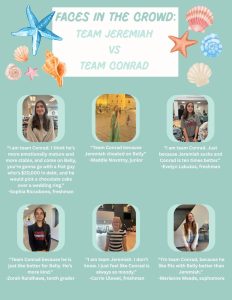Make your morning mindful
Ms. Hoffman is one of many members of the George Mason community concerned about the increase in toxic stress levels among students and teachers. To help alleviate this ever-present “sense of overwhelming,” she has been holding mindfulness sessions every Wednesday before school. The photographer decided not to take a picture of the meeting since Ms. Hoffman believes it is supposed to be a low-stress environment and was worried about the attendees’ comfort.
March 5, 2019
“The ‘Moment of Morning Mindfulness’ – such a tongue-twister,” I commented.
“It is!” said Ms. Sharon Hoffman. “And I don’t even call it that, really. I would just call it ‘Mindful Morning.’”
Ms. Hoffman is the brain behind the Moment of Morning Mindfulness, an open-door session held every Wednesday in room D125, from 7:40 a.m. to 8 a.m.. The primary purpose of the Mindful Morning is to encourage awareness in the George Mason community and help students and faculty manage stress in new ways.
“I think we all recognize that there are a lot of students in our community—and teachers—that have this sense of overwhelming anxiety, and we want to be able to reach as many people as we can when they need it,” Hoffman said.
She was inspired by the long-term practice she has done on her own.
“As I acquired and realized the benefits for myself, I was like, ‘Oh my gosh, I have to bring this to the students, I have to bring this to school.’ So I became trained through an organization called mindfulschools.org.”
Mindful Schools, founded in 2007, is an organization dedicated to the integration of mindfulness curriculum in schools worldwide. Ms. Hoffman is one of over 50,000 people who work with children and adolescents, and have been trained by Mindful Schools’ team of educators.
“Mindfulness is being aware, paying attention,” Hoffman said during the February 13 Moment.
The theme for that session was ‘heartfulness,’ which is defined on the Mindful Schools website as: “The intentional nurturing of positive mental states such as kindness and compassion.”
First, all attendees of the Mindful Morning wrote how they were feeling on an index card, with a number one through five, representing the intensity of that feeling.
Next, Hoffman led a group discussion on the week’s theme. For heartfulness, she asked what the others believed brought about happiness, and what kind of positive contagions they could think of. Examples of contagions included laughter, smiles, and niceness.
She then guided participating people through a mindfulness exercise. They were encouraged to plant their feet flat on the floor, close or soften their eyes, and clear their minds of unrelated thoughts. She told them to think of someone they love and imagine that person doing something they love. Lastly, she instructed them to send good thoughts to their loved ones, like, “I want you to be happy.”
The session concluded with everyone writing how they felt after the exercise on the back of their index card, and a new number representing the updated intensity of their pre-exercise feeling.
Personally, I wasn’t sure what I was getting into that morning, but I’m glad I went. I was left with a warm, fuzzy feeling throughout my body, which lingered for almost half of the ensuing eight hours. It was only chipped away by the wear-and-tear of a standard school day.
Ms. Hoffman’s final thoughts were that “there’s no commitment to it, and it’s really just ‘If you need a little something, come on by and learn a new skill.’ ”









